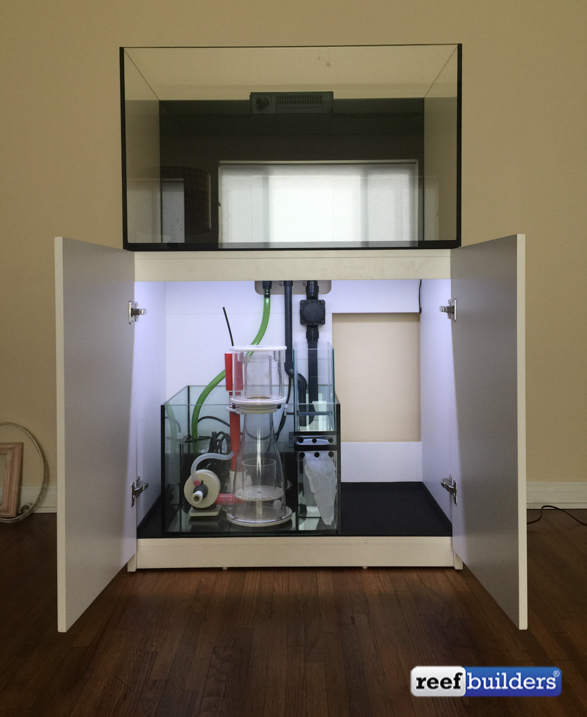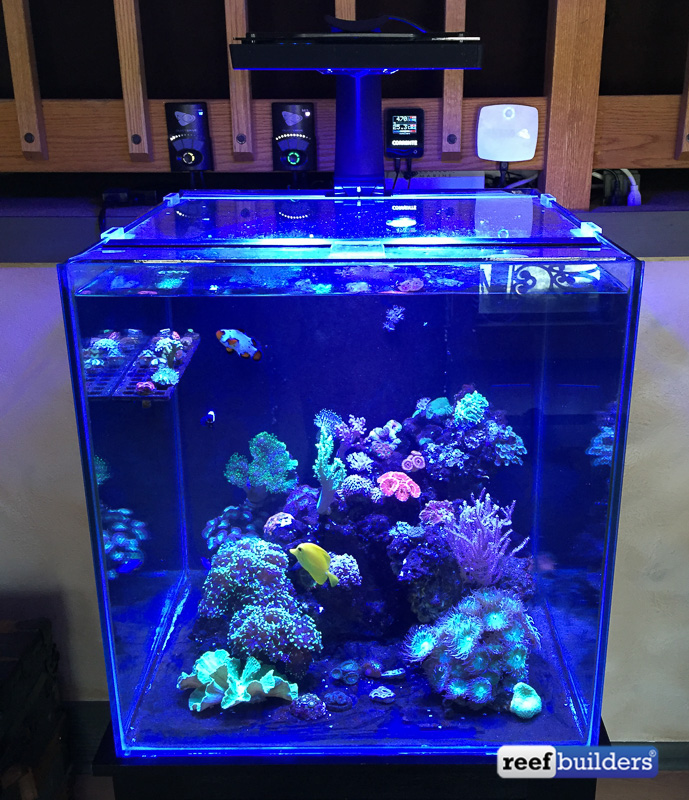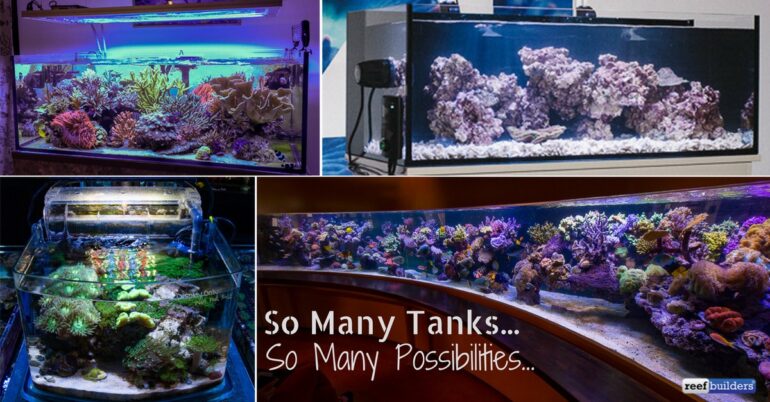When you’re considering your first reef aquarium, one of the things you probably need to give more thought to is…your aquarium! And now, more than ever, there are multiple options. For your first reef tank, a realistic option might be the “all-in-one” aquarium.
Yes, I’m serious.
There are a bewildering number of options for aquariums that simply didn’t exist a decade ago. And, because you have the ability to purchase a turnkey, all-in-one system that takes away many of the difficult equipment choices you have to make when doing it from scratch, this aspect of your first aquarium setup can be simplified dramatically.
It’s not a panacea, however- because you still kind of need to wade through the many options available to find the one that best suits you. Not hard, but you need to be careful, even now. In the past, some all-in-one, turnkey systems had equipment options that left much to be desired, like undersized, quasi-functioning, “lowest common denominator” skimmers, sumps, and reactors. This had the net effect of tainting the whole category for many years.
Not anymore. We’re happy to see that this trend has largely changed, and manufacturers have indeed “wised up” and now offer systems with some amazingly nice components, well-matched for performance, functionality, and tank size. They’re a fabulous option for the beginner, but you need to do some homework, some asking around on forums- and in some cases, some minor modifications.

And sure, you can go full-on custom, starting with a high-concept design from day one, with a really nice tank and high end components that you can always use on later tanks. Not a bad strategy if you make good decisions, but don’t skimp on quality, and think about how the tank will fit into your future hobby plans. Quality first. Just don’t skimp on components like skimmers and pumps, adopting the whole “I’ll get a better one down the line…” mindset.
Oh, and there’s the whole “size” thing. Yup, you ask 50 different reefers, you’ll probably get 50 different answers, but many will tell you that it makes so much sense to invest in the largest system you can afford. It’s tough on the surface to argue with this advice. Not only for the obvious reason (you can put more stuff in there!), or the less obvious, but equally well-discussed reason (larger tanks, with their greater water volumes, are less prone to environmental fluctuations).
However, the best “argument” for getting the largest tank you can should be this brutally honest, really simple one: If you get hooked on this hobby, you’ll eventually outgrow the current tank you have. By “outgrow”, I mean that, even if you think you won’t need all of that space now, you will- and far sooner than you think. It’s like a “universal constant” in the hobby. The best way to “future proof” your tank is to:
a) Start with one that’s large enough to accommodate more livestock than you think you are interested in keeping now and into the foreseeable future.
b) Invest in an aquarium that has a fully open top, wide front-to-back-dimensions, and a large, well-designed overflow weir with plumbing connections larger than what’s “minimally acceptable.”
c) Purchase or build the largest sump your stand can comfortably accommodate. A sump, being the “hub” of your water-processing, not only provides ample room for all of those fun gadgets- it adds significant water volume to your system, further increasing stability and overall performance. In fact, I’d recommend the following unorthodox practice: Start with the largest sump you can! It will provide stability, it’s less expensive than starting with a large tank, and can always become part of a larger system down the line.
Look, I get it. You may have some limitations, in terms of available space, finances, etc. that impact the size of the system you will start with. Your desires may say “225 gallons”, but your budget and other restrictions might scream, “25 gallons!” Or even 10. In that instance, you simply have to double down on technique and learn from the get-go the awesome power of restraint. And nano tanks.
Nano Reef Tank
Nano tanks might be your answer. Now, I’ll be up front about nanos. This is not the same reef world that I grew up in. “Back in the day”, it was like, “Why start by making the odds of success smaller?” Not anymore, at least from a purely “size and functionality” standpoint. They are no longer the scary, undersized, low-functioning, cheaply-made, under-equipped death traps that were the reef equivalent of a “Supermax” prison cell from years past. Yup, the “postmodern” nano is now a legitimate, highly-evolved, fully functional, and even customizable alternative to a larger aquarium.
However…Much to the chagrin of many manufacturers and nano enthusiasts, I still wouldn’t start with one unless you absolutely have to. Why? Well, because, for one thing, as you’ve been told already, smaller water volumes are inherently more difficult to keep environmentally stable, prone to fluctuations in both temperature and water chemistry- critical components of your aquatic environment.

Why start with one hand tied behind your back and have these important factors keep you on the aquarium equivalent of “DEFCON 2” all the time?
And you’re simply not going to be content with a 5 or 10 gallon reef tank. Period. “Reef tank” essentially means “vehicle to enable the continuous collection and purchase of lots of fishes and corals..” Seriously- look it up. You’re just going to get a larger tank eventually, anyways. I know this for a fact.
Now, don’t get it twisted. Nanos are the PERFECT tanks for trying out crazy new ideas on a small, manageable, and affordable scale. “Proof of concept” platforms for future scaled-up reefs; testbeds for exotic stuff you wouldn’t necessarily want to take a first crack at in a 150. You can set ‘em up and break ‘em down with relatively little pain and cost, so they are really great to have for more advanced hobbyists.
I just think they’re a bit too limited for the bulk of neophyte reefers who have aspirations (and the space or financial resources) to make a larger tank a reality.
Now, I know the common antidote is to default to what we already addressed above, and tell newbie reefers to purchase the largest system they can…and that’s not the worst advice I could give. However, when you think about it-and I’m trying not to sound like a jerk- if you don’t have the “chops” to run a 40-50 gallon reef, you’ll totally hate life (and me) if you get peer-pressured into starting with a 100-200 gallon tank right off the bat. The expense, effort, and time you’ll need to apply to a larger tank might erode some of the joy for a newer reefer right from the start.
Yeah, I’d avoid either extreme, really, and plant yourself somewhere in the 40-60 gallon range. Maybe 75 gallons if you push it. This is a great size range for you to play with, because you’re not “hyper limited” as to the types of corals and fishes you can keep, it’s not breathtakingly expensive to equip properly (but you can still spend a mint on outrageous tech if you WANT to…), it’s a nice stable volume (ie; forgiving of occasional lapses in husbandry), and is interesting and enjoyable enough to scape and expand to for a long time to come. Oh, and good “AIOs” are available in that size range now, too!

Okay, I suppose we’ve pretty much beaten this size thing enough. One more time” Find the middle and start there. Get the BEST system you can afford, instead of the largest.
Oh, and one more thing…
Just because you’re starting with say, a 60-75 gallon tank, doesn’t mean you HAVE to fill it to the brim with a ton of rock, corals, and fishes as soon as possible. Again, deploy that patience thing I beat you with in my last installment. What’s the big rush? Take your time and grow into it. That’s part of the beauty of a larger tank- you can “evolve” it and enjoy each part of the process…There is not rule in reefing that says you must get your tank fully stocked in 3 months, or whatever. Besides, there will always be an ample supply of overhyped, overpriced microchip-sized coral frags available from any number of Facebook “vendors” when you feel compelled to throw caution to the wind and spend mad coin, trust me.
Okay, that’s your dose of reality for this week from your favorite pain-in-the-dorsal side…
Stay excited. Stay committed. Stay engaged.
And Stay Wet.



